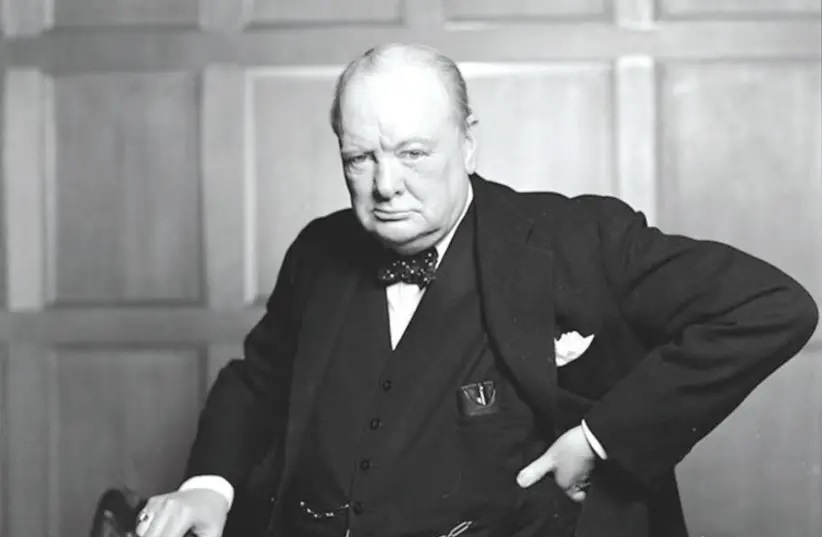Blog by Dr. Shimon Samuels published in The Jerusalem Post
16 February 2020
https://www.jpost.com/Opinion/Churchills-definition-of-Belgium-A-manufactured-country-617734
“Usury” was the grounds for deportation of the Jews of Antwerp by the Duke of Brabant in 1261, who called for them to be expelled or destroyed.

Sir Winston Churchill, 1941. Photo Biblioarchives/Libraryarchives/Flickr.
As Belgium today leads a United Nations Security Council campaign against Israel, while crying for dead Jews of 75 years ago at the Jerusalem Holocaust Forum, we may find Winston Churchill's definition eminently relevant:
“Wherever there are three Jews, it will be found that there are two prime ministers and one leader of the opposition. This applies to Flemish – and French-speaking Belgians. Belgium is a ‘manufactured country.’ An opinion rarely satisfies both sides.”
While the 40-year (1922-1962) Belgian colonialism in Rwanda-Burundi and the Congo primarily brought merchants bent on enrichment and usury, they were followed by more brutal “eugenists,” measuring the circumference of Tutsi skulls and noses with their calipers. Obsessed with racial/ethnic classification, they claimed the Tutsis superior to the Hutu, ironically calling them “the Jews of Africa.” In reality, these were precursors to the twisted experiments of Josef Mengele. Belgium thus left a legacy that erupted in the 1994 Rwandan genocide.
“Usury” was the grounds for deportation of the Jews of Antwerp by the Duke of Brabant in 1261, who called for them to be expelled or destroyed. In the 14th century, another Duke of Brabant drove Jews from Brussels and Liege.
In April 1941, more than 200 Flemish National Unionists committed the “Antwerp pogrom,” burning two synagogues and smashing Jewish shops. In 1942-1944, more than 25,000 Jews were deported from Belgium, mostly to Auschwitz, via the SS Mechelen transit camp. Of these, less than 1,000 survived.
While approximately 20% were arrested by local police, most were hidden by “Righteous Gentiles,” and many joined the Resistance.
Our office followed the post-war activities of collaborator, Walloon (Flemish) SS battalion volunteer Leon Degrelle, who fled to Francisco Franco’s Spain in 1945. There, he led neo-Nazi and Holocaust denial groups, such as CEDADE (Spanish Circle of Friends of Europe) and its publishing house in Barcelona. Attempts to extradite this war criminal to Belgium – even after the death of Franco and his regime – for trial failed, apparently due to lack of political will.
Nevertheless, in 1991, we assisted the late survivor, Violeta Friedman, in her case at the Spanish Constitutional Court against Degrelle’s Holocaust denial. He was sentenced on the charge of “having offended the honor and memory of the victims.” The court’s decision was a precedent leading to reform of the Spanish Criminal Code.
Until his death in 1994, Degrelle threatened the Wiesenthal Center with a defamation suit for calling him a Belgian war criminal.
In 2017, Belgium and France submitted to the UNESCO World Heritage Committee a list of 137 World War I cemeteries as sites to be acknowledged as symbols of reconciliation. Present at the session, I identified sites where World War II graves had been added.
On the French side, the War Cemetery of La Cambe holds the graves of SS perpetrators of the massacre at Oradour-sur-Glane, where 642 villagers were burned alive as retaliation against the Resistance.
The Belgian list included the Yser Tower Memorial in Diksmuide, a monument to the soldiers who fell in World War I that had become the pilgrimage shrine for the Flemish Nationalist movement. For the last 25 years it is, each summer, a rallying point for neo-Nazis from across Europe.
I argued that “there can be no reconciliation between the sons of light and the sons of darkness of World War II.”
The French ambassador diplomatically announced the withdrawal of the entire proposal. His Belgian counterpart was not so polite.
In 2009, UNESCO granted World Cultural Heritage status to the Flemish city of Aalst. Its 2013 Carnival saw a float portraying SS-uniformed actors whipping victims in concentration camp garb, holding cannisters marked “Zyklon B gas.”
In 2019, the float displayed Jewish stereotyped figures grasping gold coins and infested by rats. Despite the Belgian authorities’ claim that these outrages were acceptable as “freedom of expression,” UNESCO joined Jewish opinion by removing Aalst’s heritage status. The signs, however, for the 2020 festival are discouraging, with little hope for Belgian governmental intervention.
Brussels, the so-called “capital of Europe,” claims a thriving Jewish community struck, no less, by antisemitic terrorism emanating from a growing demographic radical and jihadist Islam.
Antwerp hosts a sizeable Jewish – mostly Orthodox – community, with many involved in the diamond industry. At a meeting of the European Union Fundamental Rights Agency, an Antwerp representative called the area around the Jewish neighborhood “Little Gaza.”
Intriguingly, an online visit to Wingie.com – a seemingly low-cost air travel online agency – offers direct flights from Antwerp to “Yasser Arafat International Airport, Gaza, Palestinian Occ. Territories,” but thankfully has no flights available.
The Belgian government’s present “policy” against the Jewish state is the latest in a long litany of antisemitism, despite the current federal prime minister being a Jew and a woman.
The Wiesenthal Center has imposed a “travel advisory” where such conditions are warranted. In addition, perhaps the diamond industry should consider its eventual departure from “Little Gaza.”
The writer is director for international relations of the Simon Wiesenthal Center.
